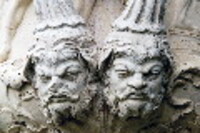| dc.coverage.spatial | Site: London, England, United Kingdom | en_US |
| dc.coverage.temporal | ca. 1769-1835 (creation) | en_US |
| dc.creator | Coade, Eleanor | en_US |
| dc.date | 1769-1835 | en_US |
| dc.date.accessioned | 2013-01-25T21:24:55Z | |
| dc.date.available | 2013-01-25T21:24:55Z | |
| dc.date.issued | 1769-1835 | en_US |
| dc.identifier | 186358 | en_US |
| dc.identifier.other | archrefid: 1764 | en_US |
| dc.identifier.uri | http://hdl.handle.net/1721.3/95552 | |
| dc.description | From 1769 ‘Mrs’ Coade (adopting a courtesy title extended to unmarried women in business) manufactured a ceramic artificial stone at Lambeth in London. It so closely resembled a natural stone that ever since it has been mistaken for it; as a result the extent of her influential business has been greatly underestimated. It survives at more than 650 sites, and hundreds more examples of its use have been recorded. The Coade Artificial Stone Manufactory produced every kind of architectural detail: capitals, friezes, quoins, voussoirs; garden ornaments, including fountains, statues and vases. From 1771 the sculptor John Bacon (i) was employed as chief designer; other sculptors, such as John Flaxman and Thomas Banks, were later involved in occasional employment by Coade. These urns are covered with motifs and figures borrowed from Classical Greek art.; From 1769 ‘Mrs’ Coade (adopting a courtesy title extended to unmarried women in business) manufactured a ceramic artificial stone at Lambeth in London. It so closely resembled a natural stone that ever since it has been mistaken for it; as a result the extent of her influential business has been greatly underestimated. It survives at more than 650 sites, and hundreds more examples of its use have been recorded. The Coade Artificial Stone Manufactory produced every kind of architectural detail: capitals, friezes, quoins, voussoirs; garden ornaments, including fountains, statues and vases. From 1771 the sculptor John Bacon (i) was employed as chief designer; other sculptors, such as John Flaxman and Thomas Banks, were later involved in occasional employment by Coade. These urns are covered with motifs and figures borrowed from Classical Greek art. Source: Grove Art Online; http://www.oxfordartonline.com/ (accessed 6/14/2009) | en_US |
| dc.format.medium | Coade stone (ceramic artificial stone) | en_US |
| dc.rights | © Scott Gilchrist, Archivision, Inc. | en_US |
| dc.subject | decorative arts | en_US |
| dc.subject | mythology (Classical) | en_US |
| dc.subject | Eighteenth century | en_US |
| dc.subject | Neoclassical | en_US |
| dc.title | Chiswick House: Italian Garden Urn Reliefs | en_US |
| dc.type | image | en_US |
| dc.rights.access | Licensed for educational and research use by the MIT community only | en_US |
| dc.identifier.vendorcode | 1A2-E-L-CH-3-A9 | en_US |
| vra.culturalContext | British | en_US |
| vra.technique | carving (processes) casting (process) fabrication attributes: ceramics | en_US |
| vra.worktype | urn | en_US |
| vra.worktype | bas-relief (sculpture) | en_US |
| dc.contributor.display | Eleanor Coade (British manufacturer, 1732-1821) | en_US |


